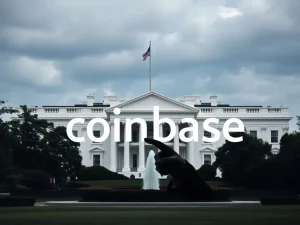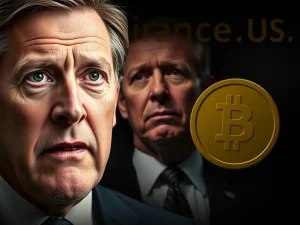Unveiling Institutional Fears: Why DeFi Adoption Faces Regulatory Hurdles

Decentralized Finance (DeFi) is touted as the future of finance, offering transparency, efficiency, and accessibility. Yet, despite its revolutionary potential, major institutions are treading cautiously. Why the hesitation? Shibtoshi, the founder of SilentSwap, a privacy-focused trading platform, sheds light on the critical roadblocks preventing widespread institutional embrace of DeFi. Let’s dive into the core concerns that are keeping traditional finance giants at arm’s length from the DeFi revolution.
Decoding Institutional Hesitation Towards Decentralized Finance (DeFi)
Institutions aren’t just being stubborn; their concerns are rooted in practical and regulatory realities. Shibtoshi points out three primary areas of apprehension:
- Privacy Concerns: The inherent transparency of blockchain, while beneficial for some, becomes a liability for institutions. Imagine publicly broadcasting your trading strategies or payroll information. For entities accustomed to discretion, this level of transparency is a significant deterrent.
- Regulatory Uncertainty: The DeFi landscape is a regulatory grey area. Questions abound: Are DeFi tokens securities? Who is accountable when a Decentralized Autonomous Organization (DAO) falters? The lack of clear, standardized compliance regulations across jurisdictions creates a minefield of legal risks.
- Complex User Experience: Navigating the DeFi space can be technically challenging, especially for large institutions with established workflows and systems. The user experience isn’t always intuitive for those accustomed to traditional financial platforms.
Shibtoshi emphasizes that while these concerns are valid, they are not insurmountable. Innovation is already paving the way for solutions. Platforms like SilentSwap are pioneering privacy-preserving protocols, making DeFi increasingly palatable for enterprise-level adoption. But what exactly are these hurdles in detail?
Navigating the Labyrinth of Regulatory Uncertainty in DeFi
Imagine trying to build a business on shifting sands. That’s the reality of regulatory uncertainty in DeFi. The fragmented global regulatory landscape poses a massive challenge for institutions seeking to engage with decentralized finance. Here’s a breakdown of the regulatory quandaries:
- Jurisdictional Fragmentation: Different countries and regions are adopting vastly different approaches to regulating crypto and DeFi. This lack of uniformity creates a compliance nightmare for global institutions.
- Token Classification Ambiguity: Are DeFi tokens securities, commodities, or something else entirely? The classification dictates which regulations apply, and clarity is sorely lacking.
- DAO Accountability: Decentralized Autonomous Organizations operate without central leadership. This raises fundamental questions about legal responsibility. If a DAO makes a mistake, who is held accountable?
Shibtoshi advocates for “sensible policies” crafted in collaboration between regulators and DeFi firms. The goal should be to foster innovation while safeguarding users, rather than imposing overly restrictive rules that stifle the sector’s growth. The recent overturning of the controversial DeFi broker rule in the US Congress signals a potential shift towards a more balanced approach.
Privacy Limitations: A Major Hurdle for Institutional DeFi Adoption
Privacy limitations in blockchain are a double-edged sword. While transparency is a core tenet of crypto, it clashes with the operational needs of many institutions. Consider these scenarios:
- Sensitive Data Exposure: On-chain transactions are public. This means sensitive business information, from trading algorithms to internal financial dealings, could be exposed to competitors and the public.
- Competitive Disadvantage: For hedge funds and trading firms, revealing trading strategies is akin to giving away trade secrets. The lack of transactional privacy puts them at a significant disadvantage.
- Data Security Concerns: While blockchain is secure, the public nature of transactions increases the surface area for potential data breaches and surveillance, raising concerns for institutions handling vast sums of capital.
However, innovation is providing solutions. Privacy-preserving technologies, like those employed by SilentSwap, are emerging to bridge this gap. These protocols utilize techniques like zero-knowledge proofs and secure multi-party computation to enable confidential transactions within DeFi, offering a pathway for institutions to participate without compromising sensitive information.
The Path Forward: Bridging the Gap Between Institutions and DeFi
Despite the existing challenges, the potential of DeFi is too significant to ignore. The key to unlocking institutional adoption lies in addressing the core concerns head-on:
- Proactive Regulatory Engagement: Open dialogue and collaboration between DeFi innovators and regulators are crucial to develop clear, balanced, and innovation-friendly regulations.
- Advancing Privacy Technologies: Continued development and adoption of privacy-preserving protocols will be paramount in making DeFi palatable for institutions requiring confidentiality.
- Improving User Experience: Simplifying DeFi interfaces and creating more user-friendly platforms will lower the barrier to entry for institutions and their clients.
The DeFi sector is still evolving. While the total value locked in DeFi hasn’t yet rebounded to its 2021-2022 peaks, the underlying technology and its potential remain robust. As Shibtoshi aptly points out, the concerns are solvable. By addressing regulatory uncertainty and privacy limitations, and by continually innovating, DeFi can pave the way for a future where institutions confidently embrace decentralized finance, unlocking its full potential to reshape the financial landscape. The repeal of the archaic DeFi broker rule in the US is a positive signal, indicating a potential move towards a more supportive regulatory environment. The journey towards mainstream institutional DeFi adoption is underway, and the innovations happening now are shaping its promising future.










